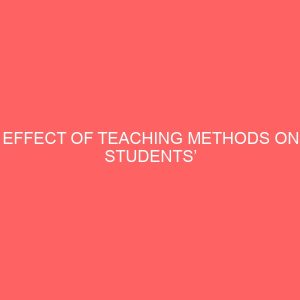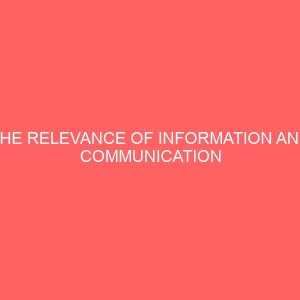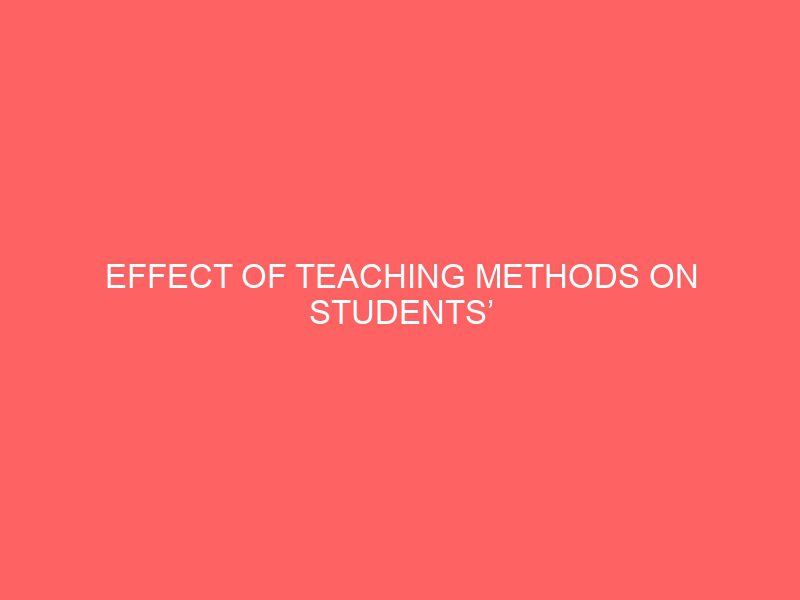Description
EFFECT OF TEACHING METHODS ON STUDENTS’ PERFORMANCE IN NIGERIAN EDUCATION INSTITUTIONS: A CASE OF PUBLIC SECONDARY SCHOOLS IN MAKURDI
ABSTRACT
The main concern in education sector is how teaching methods affect students’ performance. This study examined teaching methods on performance of students in public secondary schools (A-level) in Nigeria where Makurdi was used as a case of study. The study was guided by three specific objectives: To identifying teaching methods used in instruction of science subjects in public secondary school, to assess students’ perception of the appropriateness of teaching methods used in teaching in public secondary school and to determine the level of relationship between teaching methods and students’ performance in public secondary schools in Makurdi. The study applied descriptive research designed that incorporated qualitative and quantitative approach. The sample of teachers 78, students 129 and inspectors 9 was surveyed using in-depth interview and questionnaire. Qualitative data was analyzed descriptively using SPSS while thematic analysis was used to analyzed qualitative data. The study findings revealed that most effective teaching methods were demonstration followed by question and answers and then brainstorming, teachers should know the value and impact of different teaching methods and regular training/workshop should be conducted on teaching methods. The study recommended that traditional methods like lecture should not be used always.
CHAPTER ONE
1.0 INTRODUCTION
1.1 Introduction
This chapter presents the background of the study, statement of the problem, objectives of the study, significance of the study, scope and limitations of the study. It also gives the conceptual framework and definition of key terms.
1.2 Background of the Study
Teaching methods are used to impart knowledge to students they are the means by which the teacher attempts to impart the desired learning or experience (Ndirangu, 2007). The choice of a particular method of teaching by the teacher determined by number of factors which includes the content to be taught, the objectives which the teacher plans to achieve availability of teaching and learning resources and the ability and willingness of the teacher to improvise if convectional teaching aids are not available, evaluation and follow-up activities and Individual learner differences (Ndirangu, 2007).
The methods used in teaching vary from one country to another, depending on the information or skills that is being taught and also be influenced by the aptitude and enthusiasm of the student. Various studies had been conducted concerning teaching methods, for example Asikhia (2010), found that, qualification of teachers and students’ environment factors do not influence students poor performance but teachers’ methods of teaching influence poor academic performance. Furthermore, the methods of teaching are dictated by the medium of instruction for example, where English is used, the method of instruction has to be more interactive than passive (Pillar and Skilling, 2005). It also argued that classroom teachers urgently need to know more about effective strategies for teaching English learners (Thompson, 2004). The commonly used teaching methods especially in developing countries are teacher centered (Guloba, Wokodola, and Bategeka, 2010), which are viewed to be somewhat ineffective in the impartation of knowledge.
These methods are no longer used in other counties. Problem-life learning as a teaching method is becoming increasing popular in education institutions as a tool to address the inadequacies of tradition teaching methods since its approaches do not encourage student to participate in the learning process (Teo and Wong, 2000). However, more recently there is an argument in education industry to adopt a learner- centered paradigm shift (Ndirangu, 2007), while other schools of thought are advocating participatory methods of teaching (Sajjad, 2011).
Despite these arrays of teaching methods being advocated in literature there is no one universally accepted method. The question still remains is which of these teaching methods contribute to failure or success of students’ performance especially in developing countries like Nigeria where the causes of poor performance in secondary schools is not well understood.
1.3 Statement of the Research Problem
Students’ performance in Nigerian secondary schools has been poor, and one of the reason cited is the type of methods of learning-teaching used. Education in Nigeria especially in community (ward) secondary schools, the majorities of students have failed or have not shown good performance in the examination results in summative evaluation (Laddunuri 2012). Marikinyo (2003), believes that the falling level of academic performance is attributed to teachers non-use of verbal reinforcement strategy. Several studies have been conducted about teaching methods in secondary schools in many parts of the world on students’ performance, for example in USA (Haas 2002), Pakistan (Sajjad 2011), Ghana (Barneka 2012), (Asikhia 2010), Uganda (Guloba, Wokadala and Bategeka, 2010) and Kenya (Njoroge et al., 2014). These studies indicated that the type of teaching methods used by teachers have an impact on students’ performance.
Most of the studies conducted in Nigeria concentrated on factors affecting students performance and policy making rather than how teaching methods influence the Students’ performance example (Laddunuri 2012), (Kkairuki, 2009) and (Kat ram, 2007). Another study by Mruma (2013) examined motivation of teachers in Secondary Schools. None of these studies have specifically examined the effect of teaching methods on student performance. This study bridges the gap and it examined effects of teaching methods on students’ performance in public secondary schools in Makurdi, Benue State, Nigeria.
1.4 Objectives of the Study
1.4.1 General Objective
The general objective of the study is to examine the effect of teaching methods on student performance in Nigerian education in public secondary school in Makurdi, Benue State, Nigeria.
1.4.2 Specific Objectives
The specific objectives guided this study were as follows;
- To identify teaching methods used in instruction of science subjects in public Secondary schools in Makurdi, Benue State.
- To assess students’ perception of the appropriateness of teaching methods used in teaching in public secondary schools in Makurdi.
- To determine the extent to which teaching methods impact on students’ performance in public secondary schools in Makurdi.
1.4.3 Research Questions
The study answered the following questions
- What are teaching methods used in science subjects in public secondary school?
- What are students’ perceptions on the appropriateness of teaching methods use to teach Science subject in public secondary school in Makurdi?
- To what extent teaching methods impact on students’ performance in public secondary schools in Makurdi?
1.5 Significance of the Study
The study is worth of academic research on the following grounds:
First, the study was expected to reveal the impact of teaching methods on students’ performance in secondary schools and contributes to the body of knowledge. Second, the study expected to provide a foundation for future researchers on literature for the topic of effects of teaching methods on student performance in science subject in secondary schools. Third, the study findings expected to beneficial to policy makers especially the Ministry of education and vocational training to put forward policies that would greatly encourage fair distribution of resources in public institutions if better results are to be obtained. Fourth, the findings also expected to benefit teachers of Secondary Schools in Makurdi since it gave the ideas of most suitable teaching methods for use in science subjects. Finally, the findings of this research expected to add the body of knowledge on teaching methods and also basis for future research.
1.6 Scope and Delimitations
The study was focused on teaching methods used and their effect on students’ performance in public secondary schools in Makurdi. The targeted population was students taking science subjects for at least one year. Two other categories are science teachers and school inspectors. Since teaching methods are so many in numbers the study was only concentrated on 7 of them which are citation, brainstorming, discussion, demonstration, lecture, presentation and seminar.
1.7 Definitions of Terms
Teaching methods: Teaching method refers to the variety of ways in which a learning task is managed to facilitate the learning process.
Secondary School: refers to post primary institution in which students receive regular instructions for four years from form 1-4.








Reviews
There are no reviews yet.